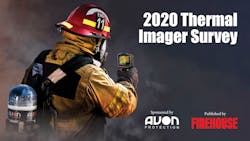Firehouse Presents Thermal Imager Survey Results
In September 2020, Firehouse and Endeavor Research invited firefighters and officers to participate in a first-of-its-kind delving into the perspective on and use of thermal imagers via an online survey. We appreciate the 682 Firehouse readers who helped us to get a better grasp on the technology and its application. Career personnel made up nearly 40 percent of respondents; volunteer personnel represented 31 percent of those who completed the survey; combination department personnel made up about 27 percent of respondents.
Two kinds of TICs
During research for the survey’s creation, concern was raised that firefighters lacked familiarity with the differences between what some instructors refer to as decision-making thermal imaging cameras (TICs) and their smaller, less-complex brethren, which some dub situational-awareness models. The concern was that some might not realize that the latter only bring a portion of the functionality to the fireground/incident/fire scene of what the former do. The survey results prove that concern was warranted.
Nearly 42 percent of respondents didn’t know of the difference between the two types. If a member who is familiar with the functionality that a decision-making model provides concludes that he/she has access to the same performance via a situational-awareness TIC, he/she can be put in danger.
Of the respondents, 18 percent learned of the difference from a firefighter or officer in his/her department. About 9 percent learned that from a member of another department. About 13 percent were clued in by a thermal imager training provider.
Training
Only 18.5 percent of respondents learned of the difference between the two types of TICs from a representative of the company from which his/her department purchased a situational-awareness thermal imager. That typifies a larger problem: a lack too often of training of any significance by the people who sell the devices. Although it is reassuring that nearly 63 percent of respondents deemed the representative of the distributor from which his/her department purchased thermal imagers either “Expert” or “Somewhat Knowledgeable” about thermal imagers, 31 percent of respondents said a representative didn’t provide any training. Only 30 percent of respondents were provided 1–2 hours of training by a representative, and only 12.8 percent received at least three hours of training from such a person.
Relatedly, 92 percent of respondents said it would be either “Somewhat Helpful” or “Very Helpful” if TIC makers would provide a training system in an electronic format. About 58 percent of respondents received less than an hour of TIC training in the past year. Forty percent of survey-takers said the state in which their department operates limits their department’s ability to train on thermal imagers because they seldomly have live-fire training.
Thirty-two percent of respondents said that their department’s training is based on NFPA 1408: Standard for Training Fire Service Personnel in the Operation, Care, Use and Maintenance of Thermal Imagers. About 25 percent said that it wasn’t; 23 percent weren’t aware that an NFPA standard regarding thermal imager training exists.
The tech
We asked survey-takers what improvement to thermal imagers impresses them the most and/or transfers best to the field. A better color palette was selected the most (30.6 percent). It was followed by the capability to record video (15.7 percent), distance-to-spot ratios (12.5 percent), smartphone-size devices (11.4 percent) and facepiece-embedded TICs (8.7 percent). Slightly more respondents (38 percent to 37 percent) believe that any market shift that plays out will do so down the road of integration into SCBA rather than handheld devices.
Only 26 percent of respondents used SCBA that has a thermal imager built into its facepiece. Of those, the largest amount (60.4 percent) considers the small screen size the disadvantage to the technology. That’s followed by the inability to turn the thermal imager 90 degrees to get a ceiling-to-floor view (45.3 percent).
Know what you don’t know
One expert with whom we spoke to prepare for this project told us that when it comes to thermal imager technology, the fire service must understand that all TICs aren’t created equal. Check out the survey to see what else firefighters said about the state of thermal imaging technology.
